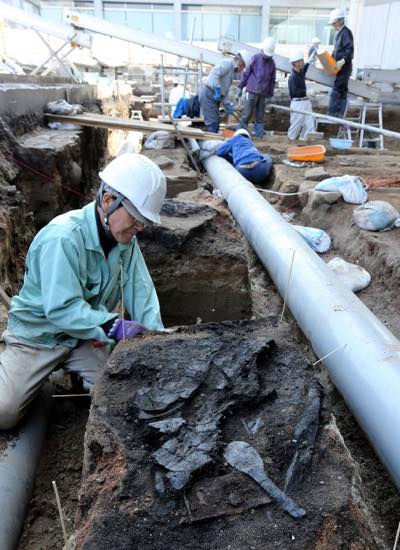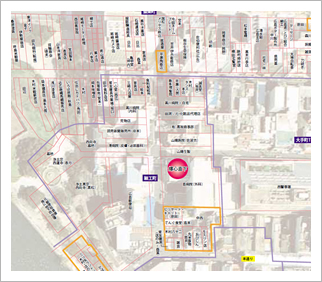
(March 2016)
The Hiroshima Peace Memorial Park attracts visitors from all around the world. Some visitors erroneously assume that this park existed even before the war and mistakenly believe that Hiroshima suffered less damage in the atomic bombing because there were few houses in the area of the bomb’s hypocenter. However, the Nakajima district, where the park is now located, was actually a busy, prosperous place from the time of the Edo period until the atomic bombing. There were homes, shops, inns, temples, even a movie theater, and the district had about 4,400 residents. The lives of these people were abruptly stolen away by the atomic bomb.
Recent excavations have found traces of streets and buildings of the old district still buried under the soil of the park. This excavation work was carried out during an investigation around the Peace Memorial Museum that ended in March 2017. Remains of the area, known as Zaimoku-cho, that were unearthed include the road surface and the layer of earth scorched by the atomic bombing, portions of an old building that was likely a public bath, and many milk bottles that were apparently located at a milk delivery business. When the digging went deeper, also discovered was a very old stone wall, which was constructed more than 400 years ago around the time Hiroshima became a castle town. After this excavation work, these locations were then backfilled, yet traces of other neighborhoods in the district, which also vanished at the time of the bombing, are surely still concealed under the ground in other parts of the park.

What was the cityscape of Hiroshima like before the atomic bombing? Wakaji Matsumoto (who died in 1965 at the age of 76), was the owner of a photo studio in downtown Hiroshima prior to the war and he took photos of the Nakajima district and the hypocenter area from the rooftop of the former Chamber of Commerce building in 1938. He also left behind other valuable photos which show the sights of the city’s streets before the bombing, at his home in Jigozen, Hatsukaichi. Through Mr. Matsumoto’s photos, we are able to recall the atmosphere of the city of those days.

In June 2000, the Chugoku Shimbun also sought to revive the old houses and streets around the hypocenter area, where the park is now located, before the atomic bombing by creating a map of the area. With support from former residents and family members of A-bomb victims in the area, the residences of that time, the demolition work that tore down buildings to create fire lanes, and the relocation of residents could be directly verified. The households and businesses were then restored on the map, which reminds us of the many lives that were lost in the A-bomb attack.
![]() Reconstruction of townscape near the hypocenter (By the Chugoku Shimbun)(PDF/7931KB)
Reconstruction of townscape near the hypocenter (By the Chugoku Shimbun)(PDF/7931KB)![]()






